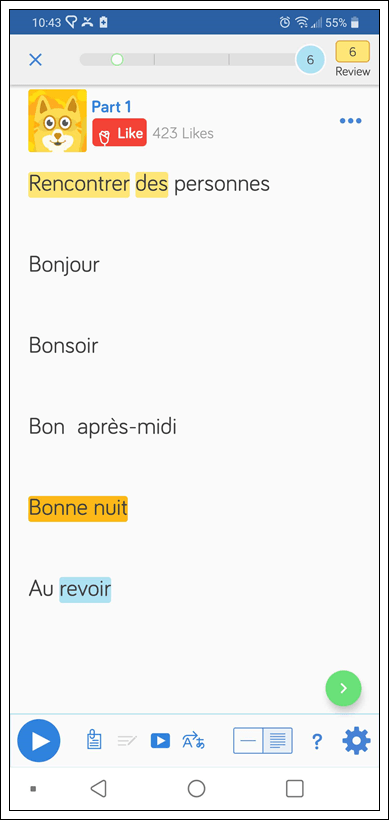French Greetings Broken Down for Beginners
In a total of about thirty countries, 275 million people speak some version of the great French language. We know that language, like other types of histories, has a story of conquest, revolution, and immigration. Wherever French evolved, it became its own distinct variety.
As we begin to discuss French greetings in this post, I can’t help but remember that it’s possible for two Francophones to speak without actually understanding one another!
Language nerd moment: French speaking people refer to themselves as “francophones” and the entirety of the French-speaking peoples of the world are collectively called “la Francophonie.”
This blog post is my best shot at summarizing a common French cultural practice with many variations: greetings. Greeting people is one of the first skills I learn when starting a new language. It’s a fairly tricky thing to learn, so I’ve got a few tips for you. But first, some housekeeping: there are way too many ways to greet people in French to look at them all, here. So, I am going to stick to France and North American dialects. As a first step, you could begin by learning how French formality influences what you say in French, especially when offering a greeting.
How to address the other person
If you’re just starting out with French, you probably aren’t all that worried about grammar rules just yet. Still, there is one grammar point that I have found extremely useful, vis à vis French greetings: formality. Everything you say after a basic greeting will turn on the concept of formality and its relationship with what you’ll say, and how.
If you already speak another non-English European language, then you know that formality is a huge deal when greeting folks without sounding like a newb. In French, there are ways of addressing people you know (informally) and people you don’t know, or for whom you must show respect (formally).
Formality works on a couple of levels, but the most important part is the word YOU. Basically, your friends are “tu” and everyone else is “vous”. The process of deciding on the appropriate level of formality in your “you” even has its own verb! The process is called “tutoyer” for deciding to use “tu” and “vouvoyer”, choosing vous.
But, wait. There’s more! The French also use “vous” to refer to a group of people. It’s the equivalent of the Southern American “ya’ll”.
Language nerds moment: “ya’ll” is thought to be a pragmatic linguistic accommodation for the lack of a plural “you” in English.
A list of informal and formal French greetings
Here’s a list of the most common French greetings. When the formality is rated at “medium” that means it’s used in both formal and informal situations. I’ve include “how are you”-type greetings because they are as common in French greeting situations as in English.
Also, you’ll notice in the chart below that the French preposition “de” is common when it comes to greetings. You can check out this post to get a more detailed look at how “de” can be used.
| French | English | Region | Level of formality |
| Bonjour | Hello (good day) / good morning | Everywhere | Medium |
| Salut | Hi | Everywhere | Low / Medium |
| Allo | Hi (common telephone greeting) | Everywhere | Low |
| Coucou | Hey, hey guys | France and Europe | Low |
| Bonsoir | Good night | Everywhere | Medium |
| Bon matin | Good morning | North America | Medium |
| Au revoir | Goodbye | Everywhere | Medium |
| Qu’est-ce qui se passe? | What’s up? | North America | Low |
| Quoi de neuf? | What’s up? | France | Medium |
| Quoi de neuf, mec? | What’s up, my dude? / ‘sup dog? | France | Low |
| Comment ça va? | How’s it going? / How are you doing? | Everywhere | Medium |
| Ça va? | How’s it going? / is everything OK? | Everywhere | Low / Medium |
| Enchanté | Nice to meet you | France and Quebec but sounds hoiti-toiti everywhere else in North America | Medium |
| Un plaisir de faire votre connaissance | Pleasure to meet you | North America, but not unheard of elsewhere | Medium / High |
| À plus tard / À toute à l’heure! | See you later! | Everywhere | Medium |
| À Taleur! | See you later! | North America | Low |
Other than “allo” (more common in a telephone conversation), all of these greetings can happen in real life or via visual and audio electronic communication. I recently wrote an entire dictionary of texting shorthand and slang – there is just as much digital slang in French as in English.
Language nerd moment: MDR is the French LOL and it means mort de rire (dying of laughter).
When you get your mind wrapped around the concept of polite French formality and its relationship to the “tu/vous” choice, you’ll understand French greetings more easily. A lot of what you say in the context of greeting someone in French will involve some variation of grammar dependant on this grammar point. Using the idea of different French greetings in different situations is good and helpful – you aren’t going to say, “Okay, have a good night!” at ten in the morning, right? – it is also useful to narrow the options by asking yourself what level of formality or familiarity is called for in a given situation.
Learning French greetings, the easy way
It’s no surprise that the more you read and listen, the faster you’ll improve. At first, reading and listening can be a bit tedious, especially when you’re using multiple resources on different apps or platforms. Not too mention, learning should be fun and enjoyable…using content YOU love 😉
That’s why there’s LingQ. LingQ is the best way to learn French online simply because you can import content you love and use it to improve your language skills. For example, you can watch, read, and listen to YouTube videos using LingQ’s one-of-a-kind reading layout that allows you to easily look up words, listen to them, and save them for review. You can do the same for music, movies, and documents too. Check out this guide to learn more about importing content into LingQ.
If you’re reading this particular post, you’re probably a beginner and need a bit of guidance when it comes to content, right? There’s over 100 lessons for beginners on LingQ that will help you get a grasp of the French language. For example, Greetings and Goodbyes.

As you can see, you can easily look up new vocabulary and listen to how the words are pronounced.
Last but not least, LingQ is available on mobile. Take your lessons wherever you go and listen to your target language, read your transcripts, and create review flashcards. LingQ’s language learning apps are available for both Android and iOS.



